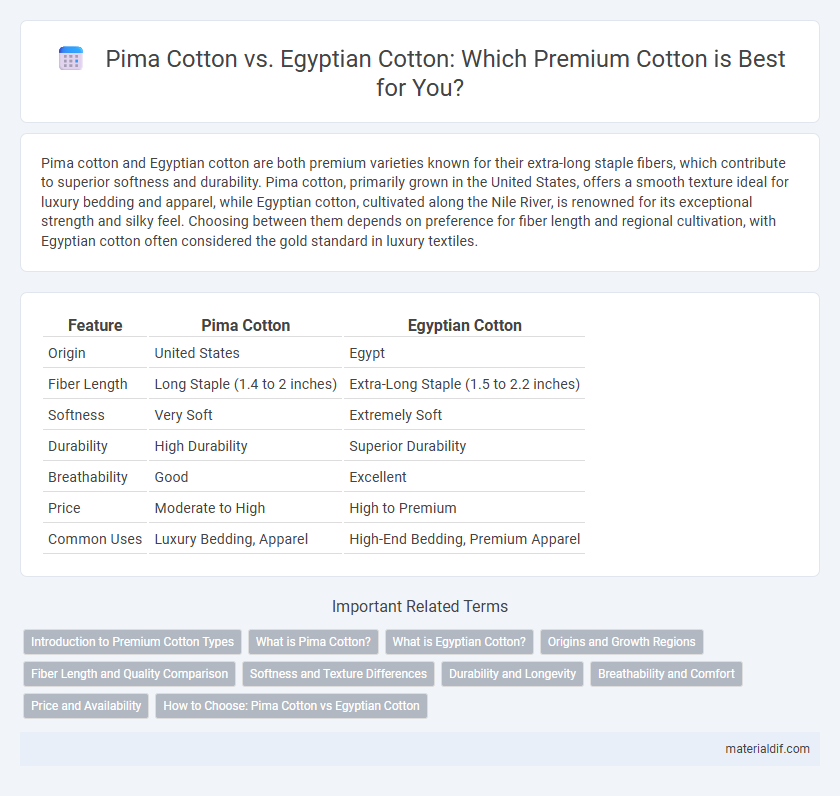Pima cotton and Egyptian cotton are both premium varieties known for their extra-long staple fibers, which contribute to superior softness and durability. Pima cotton, primarily grown in the United States, offers a smooth texture ideal for luxury bedding and apparel, while Egyptian cotton, cultivated along the Nile River, is renowned for its exceptional strength and silky feel. Choosing between them depends on preference for fiber length and regional cultivation, with Egyptian cotton often considered the gold standard in luxury textiles.
Table of Comparison
| Feature | Pima Cotton | Egyptian Cotton |
|---|---|---|
| Origin | United States | Egypt |
| Fiber Length | Long Staple (1.4 to 2 inches) | Extra-Long Staple (1.5 to 2.2 inches) |
| Softness | Very Soft | Extremely Soft |
| Durability | High Durability | Superior Durability |
| Breathability | Good | Excellent |
| Price | Moderate to High | High to Premium |
| Common Uses | Luxury Bedding, Apparel | High-End Bedding, Premium Apparel |
Introduction to Premium Cotton Types
Pima cotton and Egyptian cotton are two of the most renowned premium cotton varieties, both prized for their exceptional fiber length and softness. Pima cotton, primarily grown in the southwestern United States, offers a strong, smooth texture with superior durability, while Egyptian cotton, cultivated along the Nile River, is celebrated for its extra-long staple fibers providing a luxurious, silky feel. These premium cotton types are favored in high-end bedding and apparel for their breathability, strength, and ability to retain color vibrancy over time.
What is Pima Cotton?
Pima cotton is a premium, extra-long staple cotton known for its exceptional softness, durability, and breathable qualities, making it highly sought after in luxury bedding and clothing. Grown primarily in the southwestern United States, Peru, and Australia, Pima cotton fibers typically measure 1.4 inches or longer, contributing to its smooth, strong texture. This characteristic differentiates Pima cotton from other cotton types like Egyptian, which also features long staple fibers but is traditionally cultivated along the Nile River with a distinct cultivation process.
What is Egyptian Cotton?
Egyptian cotton is a premium variety of cotton known for its extra-long staple fibers, which contribute to its superior softness, strength, and durability. Grown primarily in the Nile River Valley, its unique climate and rich soil create ideal conditions for producing high-quality cotton used in luxury textiles and bedding. Unlike Pima cotton, Egyptian cotton fibers are often finer and longer, resulting in a smoother, more breathable fabric that enhances comfort and longevity.
Origins and Growth Regions
Pima cotton, originally developed in the southwestern United States, is primarily grown in California, Arizona, and New Mexico, known for its extra-long staple fibers that contribute to superior softness and durability. Egyptian cotton, cultivated mainly along the Nile River Valley, thrives in Egypt's unique climate and fertile soil, producing fibers that are exceptionally fine and strong. Both types of cotton are prized for luxury textiles, with their distinct growing regions influencing fiber quality and characteristics.
Fiber Length and Quality Comparison
Pima cotton features extra-long staple fibers averaging 1.4 to 2 inches, offering superior softness, durability, and resistance to pilling compared to standard cotton. Egyptian cotton boasts some of the longest staple fibers in the world, typically measuring 1.5 to 2 inches, renowned for exceptional strength, softness, and a luxurious texture. Both fibers rank high in quality, but Egyptian cotton is often preferred for premium bedding due to its longer fiber length and finer texture.
Softness and Texture Differences
Pima cotton features extra-long staple fibers that produce a smoother and softer texture compared to regular cotton varieties, making it highly desirable for luxury bedding and garments. Egyptian cotton also boasts long fibers, but is often praised for its fine, silky feel and superior durability, resulting in a more breathable and lightweight fabric. While both types excel in softness, Pima cotton tends to be slightly thicker and plush, whereas Egyptian cotton offers a more refined and crisp texture.
Durability and Longevity
Pima cotton boasts extra-long staple fibers that contribute to superior durability and resistance to pilling compared to standard cotton varieties. Egyptian cotton, renowned for its long fibers, offers exceptional strength and longevity, often maintaining softness and quality through numerous washes. Both types excel in durability, but Pima cotton generally provides enhanced resilience, making it ideal for long-lasting textiles.
Breathability and Comfort
Pima cotton features long fibers that create a soft, breathable fabric ideal for warm climates, while Egyptian cotton is renowned for its extra-long staple fibers that enhance both breathability and luxurious comfort. Both cotton types wick moisture efficiently, but Egyptian cotton typically offers a slightly smoother texture and superior airflow, making it exceptionally comfortable for sensitive skin. Consumers seeking optimal breathability often prefer Egyptian cotton for its lightweight feel, whereas Pima cotton balances durability with softness for everyday comfort.
Price and Availability
Pima cotton typically commands a higher price than Egyptian cotton due to its exclusive cultivation primarily in the southwestern United States, resulting in limited global availability. Egyptian cotton, grown mainly in the Nile River Valley, tends to be more widely available internationally, often making it more affordable for consumers. Both types are prized for their long fibers and durability, but market demand and regional production constraints heavily influence their pricing and accessibility.
How to Choose: Pima Cotton vs Egyptian Cotton
Choosing between Pima cotton and Egyptian cotton depends on fiber length, softness, and durability preferences. Pima cotton, known for its extra-long staple fibers, offers exceptional softness and strength ideal for everyday luxury bedding. Egyptian cotton typically features longer fibers and a smoother finish, making it better suited for those prioritizing high thread count and silky texture in premium linens.
Pima Cotton vs Egyptian Cotton Infographic

 materialdif.com
materialdif.com